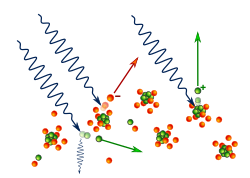| Light–matter interaction |
|---|
 |
| Low-energy phenomena: |
| Photoelectric effect |
| Mid-energy phenomena: |
| Thomson scattering |
| Compton scattering |
| High-energy phenomena: |
| Pair production |
| Photodisintegration |
| Photofission |
Compton scattering (or the Compton effect) is the quantum theory of high frequency photons scattering following an interaction with a charged particle, usually an electron. Specifically, when the photon hits electrons, it releases loosely bound electrons from the outer valence shells of atoms or molecules.
The effect was discovered in 1923 by Arthur Holly Compton while researching the scattering of X-rays by light elements, and earned him the Nobel Prize for Physics in 1927. The Compton effect significantly deviated from dominating classical theories, using both special relativity and quantum mechanics to explain the interaction between high frequency photons and charged particles.
Photons can interact with matter at the atomic level (e.g. photoelectric effect and Rayleigh scattering), at the nucleus, or with just an electron. Pair production and the Compton effect occur at the level of the electron.[1] When a high frequency photon scatters due to an interaction with a charged particle, there is a decrease in the energy of the photon and thus, an increase in its wavelength. This tradeoff between wavelength and energy in response to the collision is the Compton effect. Because of conservation of energy, the lost energy from the photon is transferred to the recoiling particle (such an electron would be called a "Compton Recoil electron").
This implies that if the recoiling particle initially carried more energy than the photon, the reverse would occur. This is known as inverse Compton scattering, in which the scattered photon increases in energy.
- ^ Pattison, Philip (1975). "X-Ray and Gamma Ray Scattering" (PDF). Warwick Database. University of Warwick: 10 – via Warwick Library.